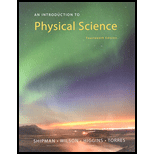
Concept explainers
A car travels on a straight, level road.
- (a) Starting from rest, the car is going 44 ft/s (30 mi/h) at the end of 5.0 s. What is the car’s average acceleration in ft/s2?
- (b) In 4.0 more seconds, the car is going 88 ft/s (60 mi/h). What is the car’s average acceleration for this time period?
- (c) The car then slows to 66 ft/s (45 mi/h) in 3.0 s. What is the average acceleration for this time period?
- (d) What is the overall average acceleration for the total time? (Note these convenient British unit conversions: 60 mi/h = 88 ft/s, 45 mi/h = 66 ft/s, and 30 mi/h = 44 ft/s.)
(a)
Answer to Problem 14E
Explanation of Solution
Given info: The initial velocity of the car is zero, final velocity of the car is
Explanation:
The formula for the acceleration is as follows,
Here,
Substitute
Conclusion:
Therefore, the average accleration of the car at the end of five seconds is
(b)
Answer to Problem 14E
Explanation of Solution
Given info: The final velocity of the car is
Explanation:
The final velocity at the end of
The formula for the acceleration is as follows,
Here,
Substitute
Conclusion:
Therefore, the average accleration of the car at the another four seconds is
(c)
Answer to Problem 14E
Explanation of Solution
Given info: The final velocity of the car is
Explanation:
The final velocity at the end of another four secondss is the initial velocity for this case.
The formula for the acceleration is as follows,
Here,
Substitute
Conclusion:
Therefore, the average accleration of the car at the another three seconds is
(d)
Answer to Problem 14E
Explanation of Solution
Given info: The final velocity of the car is
Explanation:
The final velocity of the car is
The total time
The formula for the acceleration is as follows,
Here,
Substitute
Conclusion:
Therefore, the overall average accleration of the car for the total time is
Want to see more full solutions like this?
Chapter 2 Solutions
Bundle: An Introduction to Physical Science, 14th Loose-leaf Version + WebAssign Printed Access Card, Single Term. Shipman/Wilson/Higgins/Torres
- SECTION B Answer ONLY TWO questions in Section B [Expect to use one single-sided A4 page for each Section-B sub question.] Question B1 Consider the line element where w is a constant. ds²=-dt²+e2wt dx², a) Determine the components of the metric and of the inverse metric. [2 marks] b) Determine the Christoffel symbols. [See the Appendix of this document.] [10 marks] c) Write down the geodesic equations. [5 marks] d) Show that e2wt it is a constant of geodesic motion. [4 marks] e) Solve the geodesic equations for null geodesics. [4 marks]arrow_forwardPage 2 SECTION A Answer ALL questions in Section A [Expect to use one single-sided A4 page for each Section-A sub question.] Question A1 SPA6308 (2024) Consider Minkowski spacetime in Cartesian coordinates th = (t, x, y, z), such that ds² = dt² + dx² + dy² + dz². (a) Consider the vector with components V" = (1,-1,0,0). Determine V and V. V. (b) Consider now the coordinate system x' (u, v, y, z) such that u =t-x, v=t+x. [2 marks] Write down the line element, the metric, the Christoffel symbols and the Riemann curvature tensor in the new coordinates. [See the Appendix of this document.] [5 marks] (c) Determine V", that is, write the object in question A1.a in the coordinate system x'. Verify explicitly that V. V is invariant under the coordinate transformation. Question A2 [5 marks] Suppose that A, is a covector field, and consider the object Fv=AAμ. (a) Show explicitly that F is a tensor, that is, show that it transforms appropriately under a coordinate transformation. [5 marks] (b)…arrow_forwardHow does boiling point of water decreases as the altitude increases?arrow_forward
- How would partial obstruction of an air intake port of an air-entrainment mask effect FiO2 and flow?arrow_forward14 Z In figure, a closed surface with q=b= 0.4m/ C = 0.6m if the left edge of the closed surface at position X=a, if E is non-uniform and is given by € = (3 + 2x²) ŷ N/C, calculate the (3+2x²) net electric flux leaving the closed surface.arrow_forwardNo chatgpt pls will upvotearrow_forward
- suggest a reason ultrasound cleaning is better than cleaning by hand?arrow_forwardCheckpoint 4 The figure shows four orientations of an electric di- pole in an external electric field. Rank the orienta- tions according to (a) the magnitude of the torque on the dipole and (b) the potential energy of the di- pole, greatest first. (1) (2) E (4)arrow_forwardWhat is integrated science. What is fractional distillation What is simple distillationarrow_forward
 An Introduction to Physical SciencePhysicsISBN:9781305079137Author:James Shipman, Jerry D. Wilson, Charles A. Higgins, Omar TorresPublisher:Cengage Learning
An Introduction to Physical SciencePhysicsISBN:9781305079137Author:James Shipman, Jerry D. Wilson, Charles A. Higgins, Omar TorresPublisher:Cengage Learning College PhysicsPhysicsISBN:9781285737027Author:Raymond A. Serway, Chris VuillePublisher:Cengage Learning
College PhysicsPhysicsISBN:9781285737027Author:Raymond A. Serway, Chris VuillePublisher:Cengage Learning Glencoe Physics: Principles and Problems, Student...PhysicsISBN:9780078807213Author:Paul W. ZitzewitzPublisher:Glencoe/McGraw-Hill
Glencoe Physics: Principles and Problems, Student...PhysicsISBN:9780078807213Author:Paul W. ZitzewitzPublisher:Glencoe/McGraw-Hill Principles of Physics: A Calculus-Based TextPhysicsISBN:9781133104261Author:Raymond A. Serway, John W. JewettPublisher:Cengage Learning
Principles of Physics: A Calculus-Based TextPhysicsISBN:9781133104261Author:Raymond A. Serway, John W. JewettPublisher:Cengage Learning College PhysicsPhysicsISBN:9781938168000Author:Paul Peter Urone, Roger HinrichsPublisher:OpenStax College
College PhysicsPhysicsISBN:9781938168000Author:Paul Peter Urone, Roger HinrichsPublisher:OpenStax College University Physics Volume 1PhysicsISBN:9781938168277Author:William Moebs, Samuel J. Ling, Jeff SannyPublisher:OpenStax - Rice University
University Physics Volume 1PhysicsISBN:9781938168277Author:William Moebs, Samuel J. Ling, Jeff SannyPublisher:OpenStax - Rice University





